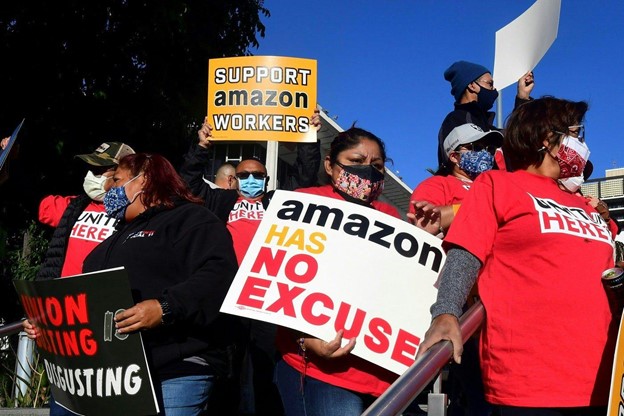Amazon and Labor Unions
Tensions continue to rise as Amazon workers fight to unionize. The battle for unionization follows rather turbulent working conditions and benefits. The subjectively sub-par work relations have long been documented and ridiculed. Some of the working conditions have been alleged to include injury hazards, unjust treatment and a lack of job security. Most of Amazon’s employee pushback takes place within its many warehouses, where a minimum of 600 people per warehouse can be found working. As workers attempt to gain stability within the company, Amazon maintains its innocence, further denouncing unionized labor. In a three month-long effort, organized Amazon employees continue to face the multi-billion dollar corporation.
Unionization endeavors became increasingly profound around the beginning of the year, in February and mid-March. Growing wearier by the day, Amazon workers took to challenge the standards of operation. The most prevalent employee resistance occurred in Alabama. Located in Bessemer, Alabama’s Amazon warehouse employees banded together to spark conversation about the vitality of unionizing. Organizers employed by the Alabama warehouse have persistently demonstrated alongside advocates. Despite painstaking advancement, continuing with contemporary warehouse operations won over the chance of unionization. In a vote of 738 to 1,798 (1,798 being the opposition), Amazon employees voice their efforts as not being over. For the better part of the year, over 6,000 Amazon employees have urged the conglomerate to join the distinguished Retail, Wholesale, and Department Store Union.
The advantages of being a part of a labor union are considerable. Strengthening employee welfare, unions have been notable for providing irrefutable change for workers. Some of the most praised worker benefits of a labor union include collective bargaining and safety within the workplace. However, the benefits do not start and end with employee gain, as organizations also notice positive distinctions. Organizational benefits of labor unions warrant increased productivity, lower turnover rates, and well-equipped staff overall. The benefits balanced between workers and an organization encourage a healthy working environment.
At the forefront, Amazon has not been a supporter of establishing a labor union. While the reason behind such a strong-willed position is unclear, company employees believe it may be due to presumed monetary loss. Accumulating approximately a million dollars per hour, it is safe to assume that Amazon prioritizes profit over employee wellbeing — possibly, more than the average business.
As demonstrations continue the fight for unionization, Amazon has conducted mass damage control. In a fairly familiar tactic for the company, Amazon has administered Twitter bots managing the role of an employee, detailing devout admiration for the company and how unionizing would ruin such admiration. In a recent letter, Jeff Bezos, Amazon founder, and CEO, stated that despite the company’s “strong relationship” with employees, Amazon needs a “better vision” in the evaluation of employee value and success.











